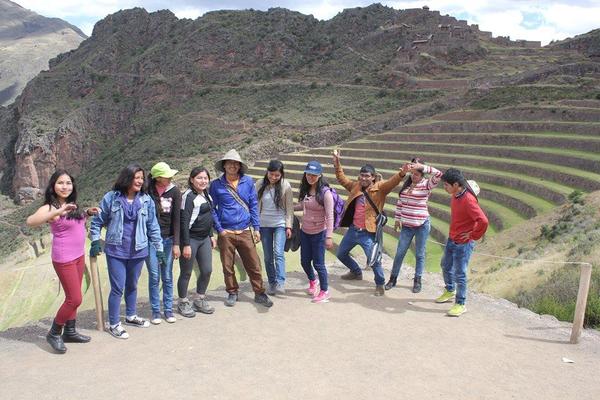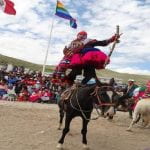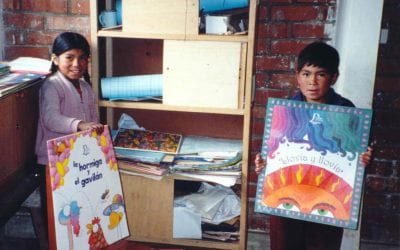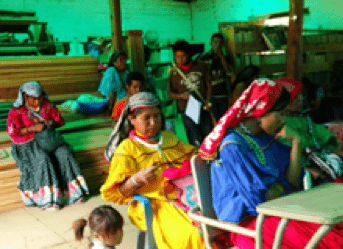Quechua-Spanish Bilinguals
Sociolinguistic Racialized Experiences in Higher Education
Quechua, a 1000-year-old indigenous language, is an official language of Peru. One out of every nine Peruvians speaks the language. In the rural areas, the figure soars to six out of every ten Peruvians. In Cusco region, both rural and urban, Quechua is still the primary language of more than half its total population. An explanation for this disparity between urban and rural use of Quechua may stem from historically scarce resources for Castilian educational reforms in rural areas of Peru.
Peru is one of the few countries in Latin America and the Caribbean that officially recognizes an indigenous language. Despite this, Quechuan peoples often won’t find a social worker, a nurse, a doctor, a lawyer or a teacher who speaks their language. Thus, they cannot participate fully in Perú’s education, health services, and economy. Discriminatory practices have been institutionalized; local people are not part of any decision-making process because top-down resolution of issues without local input continues.
Quechua speakers primarily have been engaged in agriculture, an activity with a very strong link with the Quechua language. However, when Quechua speakers migrate to cities like Cusco to seek employment or higher education at the university, they are at an extreme disadvantage because Spanish is the primary, often sole, language spoken and written.
Historically, this language was promoted during the Inka and Colonial eras. However, after the revolt against the Spanish Viceroyalty in Peru led by Tupac Amaru II and Micaela Bastidas, policies were created to facilitate the disappearance of the Quechua language as punishment for its use throughout the indigenous and mestizo uprising of the 18th century. In the 20th century, the situation changed and legislation recognized several languages, including Quechua.
But inequalities persist. A good first step toward resolving this situation is to honor the importance of the Quechua language—requiring Quechua-Spanish bilingual professionals to use Quechua in all negotiations and transactions pertaining to Quechuan communities. In the Universidad San Antonio Abad del Cusco, the region’s only public university, the bilingual Spanish-Quechua student population that has Quechua as their mother tongue exceeds 30% of its total population, yet only 2% of Quechuan college students use their birth language while in college.
Will these future professionals contribute to resolving the inequities of access to public systems for the Quechuan peoples, or will they endorse the status quo of Spanish-dominant communication? Why is this thirty percent of the student population who enter college as Quechua-Spanish bilinguals not being encouraged to sustain their use of Quechua?
Indeed, an effort exists to increase the number of young professionals who speak Quechua., Universities in Cusco, for instance, offer the Quechua language as one option among the requirements to graduate. Even with this emphasis, Quechua ranks third to Italian and English as a language choice by students. Why is this? Thirty percent of the student population in Cusco comes to college as Quechua-Spanish bilinguals already but what happens to these students is alarming.
Bilingual students choose to stop speaking their mother language Quechua because they believe it will harm their Spanish skills, according to studies on the subject. This subtractive view of Quechua-Spanish bilingualism is rooted in negative language attitudes and discriminatory acts that the Quechuan students suffer when speaking their Spanish bilingual variation of Spanish. This variation is characterized for carrying morphosyntactic and phonological features from Quechua into Spanish.
Andean college students in Cusco, Peru, struggle to overcome discrimination against Quechua-Spanish bilingualism during college.
In pursuit of this goal, bilingual Quechua-Spanish college students at the San Antonio de Abad Public University (UNSAAC) became participants in the Photovoice program in 2017 to raise awareness of Quechua-Spanish bilingual ideologies in Cusco through the presentation of visual metaphors in photo exhibitions. Photovoice refers to participatory visual methodology, as well as the photographs produced by participants engaged in the process. Photovoices document the situations that matter to the participants and serve to stimulate critical discussions with community members, as well as policy makers, to improve a particular situation.
Recognizing Supay Within Oneself
Bilingual students are well aware of racial discrimination based on speaking Quechua and having a Quechua last name. Their self-suppression of their bilingual ability reveals students’ perception that internal colonialism is still present among students and faculty. Recognizing the supay is necessary to trace it and individually or collectively dismantle it.
Supay (coloniality force), as a Quechua verb, means acting in a malicious or malevolent manner, this acting with ill intent holds the possibility of change. In this article, the Supay theme focuses on how students identify the wrong-acting of the collective unconscious as well as how photovoice participants, bilingual college students, challenge this maleficent act that limits the Quechua-Spanish bilingual practices. Photovoice participants identified a supay present in different spheres: individual, communal, and institutional.
As an example, I draw on the description provided by one of the photovoice participants, Diana. Diana depicts supay poignantly in her selection of visuals and narrative presented in the brochure of her photovoice study (Figure 2).

Supay To Act with Ill Intent Yet with Transformative Potential. Figure 2. An entry in the brochurecreated collectively to show some of the photographs of the photovoice participants, as well as their narratives. D. Ventura Aucca, 2017.
Diana took a picture of herself about to stamp on the flower. Her visual metaphor clearly demonstrates supay as a self-oppressive force feeding off the prejudice and discrimination that restricts the use of the Quechua language at the university.
The bilingual students face ongoing supay when enacting their Quechuan practices rooted in collective memories and knowledge, decolonial forces that call for social justice for Quechua peoples. Despite these limitations, Andean students also recognize the importance of their background and commitment to the Quechuan peoples through lazos (ties).
Lazos has helped create personal spaces within the university through decolonial gestures towards supporting the use of Quechua, to gain respect for Quechuan peoples and Quechuan knowledges, and to battle against negative views of bilingual students. These actions in turn encourage Quechua to flourish on campus.
Nilda’s photograph shows the symbolic evidence of the Incan presence. We have two flags: the Peruvian flag, white and red, and the flag of Tahuantinsuyo (that name of the territory occupied by the Incan civilization), the colors of the rainbow. We also have an example of a Quechua tradition called Tupay, an annual celebration in Kunturkanki that perhaps dates to pre-Incan times and has taken on elements from the colonial period such as the use of the imagery of the horse. Although Nilda links the Quechua language with the Incas, she also claims to be aware that valorizing Quechua is not just about treating it as an object of folklore but also about planning for its permanence in new generations using concrete facts (Figure 3).
Collective Memory in Motion
For many students, their reason for speaking Quechua is closely linked to their socioecological roots, a collective historical identity that resonates to their present through the linguistic practices of their communities, their cultural practices, and their grandparents. Students state that this past—which flows in the present—causes them to continue their bilingual practices in opposition to a society that still cultivates an inferiority complex associated with such practices.
When bilingual students speak Quechua, it is part of their experience passing through Quechua and non-Quechua spaces yet also of carrying space-time in their memories. Through his photography (Figure 4), Gabriel Quispe Huayhua shows us the vitality of the Quechua language that allows him to inhabit the past and present in space and time.
Collective memory relates directly to the Quechua language for students. That is why they believe bilingual practices sustain memories of their origins. For them, origins define their past and present as a continual march forward in their Quechua communities through iterative cultural practices and pertinent references to ancient Incan and pre-Incan civilizations.
A particular space that Andean students identified as a place where they can nurture Quechuan knowledges and practice the Quechua language is the Intercultural Volunteering Hatun Ñan group (VIHÑ, Spanish-Quechua Acronym). This is a student group managed by students who self-identify as indigenous either Andean or Amazonian. Photovoice participants in this study are active members in the VIHÑ who collectively, constantly battle the deficit views to their bilingual and multicultural backgrounds.
Although VIHÑ’s cultural activities for university students within and outside the university campus have enabled the organization has promoted the valorization of Quechua at the university, the photovoice sessions allowed the students to formulate new proposals for intercultural dialogue. The VIHÑ students are keen to expand their intercultural dialogues, to have more dialogue between students, and to extend intercultural dialogue to Quechua communities (Figure 4).
Connection to the Quechua community through the critical collective memory, sense of collective justice and communal Quechua knowledges are sources of support that bilingual students know they must practice if they wish to sustain their Quechua language. These students desire support from the university community, hoping it will increase its appreciation of and connection to the Quechua language to truly serve all citizens of the region and the country. Photovoice participants shared personal experiences as bilingual students facing barriers to maintaining their Quechua language, and then shared their proposals for encouraging their university create a fertile terrain for bilingualism, rooting out ideologies of deficits towards Quechua, and promoting T’ikarinanpaq, the fomenting of Quechuan practices, both language and culture, in college.
As tangible evidence of equality and respect, they perceive achieving Quechua T’ikaraninpaq as closely linked to language equity, a crucial right that is often lessened for Quechua speakers since this population lacks equal access to basic services and their view of the (Andean) world is ignored and delegitimized. Ultimately, demanding respect for the Quechua language is their primary vehicle for attaining T’ikarinanpaq.
Bilingües quechua-español
Experiencias racializadas sociolingüísticas en la educación superior
Por Yuliana Kenfield
El quechua, una lengua indígena de 1000 años, es una lengua oficial del Perú. Uno de cada nueve peruanos habla el idioma. En las zonas rurales, la cifra se eleva a seis de cada diez peruanos. En la región de Cusco, tanto rural como urbana, el quechua sigue siendo el idioma principal de más de la mitad de su población total. Una explicación de esta disparidad entre el uso urbano y rural del quechua puede provenir de recursos históricamente escasos para las reformas educativas castellanas en las zonas rurales del Perú.
Perú es uno de los pocos países de América Latina y el Caribe que reconoce oficialmente una lengua indígena. A pesar de esto, los pueblos quechuas a menudo no encuentran un trabajador social, una enfermera, un médico, un abogado o un maestro que hable su idioma. Por lo tanto, no pueden participar plenamente en la educación, los servicios de salud y la economía del Perú. Se han institucionalizado las prácticas discriminatorias; la gente local no es parte de ningún proceso de toma de decisiones debido a que la resolución vertical de las problemáticas sin aportes locales continúa.
Los hablantes de quechua se han dedicado principalmente a la agricultura, una actividad con un vínculo muy fuerte con el idioma quechua. Sin embargo, cuando los hablantes de quechua emigran a ciudades como Cusco para buscar empleo o educación superior en la universidad, se encuentran en una desventaja extrema porque el español es el idioma principal, a menudo el único, hablado y escrito.
Históricamente, este idioma fue promovido durante las épocas Inka y Colonial. Sin embargo, después de la revuelta contra el virreinato español en Perú liderada por Tupac Amaru II y Micaela Bastidas, se crearon políticas para facilitar la desaparición del idioma quechua como castigo por su uso durante todo el levantamiento indígena y mestizo del siglo XVIII. En el siglo XX, la situación cambió y la legislación reconoció varios idiomas, incluido el quechua.
Pero las desigualdades persisten. Un buen primer paso para resolver esta situación es honrar la importancia del idioma quechua, exigiendo que los profesionales bilingües quechua-español utilicen el quechua en todas las negociaciones y transacciones relacionadas con las comunidades quechuas. En la Universidad San Antonio Abad del Cusco, la única universidad pública de la región, la población estudiantil bilingüe español-quechua que tiene el quechua como lengua materna supera el 30% de su población total; sin embargo, solo el 2% de los estudiantes universitarios quechuas usan su idioma natal mientras en la Universidad.
¿Estos futuros profesionales contribuirán a resolver las desigualdades de acceso a los sistemas públicos para los pueblos quechuas, o respaldarán el statu quo de la comunicación dominante en español? ¿Por qué este treinta por ciento de la población estudiantil que ingresa a la universidad como bilingües quechua-español no está siendo alentado a mantener su uso del quechua?
De hecho, existe un esfuerzo para aumentar el número de jóvenes profesionales que hablan quechua. Las universidades en Cusco, por ejemplo, ofrecen el idioma quechua como una opción entre los requisitos para graduarse. Incluso con este énfasis, el quechua ocupa el tercer lugar en italiano e inglés como idioma elegido por los estudiantes. ¿Por qué es esto? El treinta por ciento de la población estudiantil en Cusco llega a la universidad como bilingües quechua-español, pero lo que les sucede a estos estudiantes es alarmante.
Universitarios Andinos. Figura 1. N. Gomez Gomez, 2017
Los estudiantes bilingües eligen dejar de hablar su idioma materno quechua porque creen que dañará sus habilidades en español, así lo explica la investigación sobre el tema. Esta visión sustractiva del bilingüismo quechua-español tiene sus raíces en las actitudes negativas del lenguaje y los actos discriminatorios que sufren los estudiantes quechuas cuando hablan su variación español bilingüe del español. Esta variación se caracteriza por llevar características morfosintácticas y fonológicas del quechua al español.
Estudiantes universitarios andinos en Cusco, Perú, luchan para superar la discriminación contra el bilingüismo quechua-español durante sus estudios universitarios.
Para alcanzar este objetivo, los estudiantes universitarios bilingües quechua-español de la Universidad Nacional San Antonio de Abad (UNSAAC) se convirtieron en participantes del programa fotovoz en el año 2017 para crear conciencia sobre las ideologías bilingües quechua-español en Cusco a través de la presentación de metáforas visuales en la foto-exposiciones. Fotovoz se refiere a la metodología visual participativa, así como a las fotografías producidas por los participantes involucrados en el proceso. Los fotovoces documentan las situaciones que son importantes para los participantes y sirven para estimular discusiones críticas con los miembros de la comunidad, así como con los encargados de formular políticas, para mejorar una situación particular.
Reconociendo a Supay dentro de uno mismo
Los estudiantes bilingües son conscientes de la discriminación racial por hablar quechua y tener un apellido quechua. La auto-supresión de su capacidad bilingüe revela la percepción de los estudiantes de que el colonialismo interno todavía está presente entre los estudiantes y el profesorado. Es necesario reconocer el Supay para rastrearlo y desmantelarlo individual o colectivamente.
Supay (fuerza de colonialidad), como verbo quechua, significa actuar de manera maliciosa o malévola, esta acción con mala intención tiene la posibilidad de cambio. En este artículo, el tema de Supay se enfoca en cómo los estudiantes identifican el mal comportamiento del inconsciente colectivo, así como también cómo los participantes de fotovoz, estudiantes universitarios bilingües, desafían este acto malicioso que limita las prácticas bilingües quechua-español. Los participantes de fotovoz identificaron un supay presente en diferentes ámbitos: individual, comunitario e institucional.
Me baso, por ejemplo, en la descripción proporcionada por una de las participantes de la fotovoz de nombre Diana. Diana representa sensiblemente a supay en su selección de imágenes y narrativa presentada en el folleto de su estudio de fotovoces (Figura 2).
Continuamente enfrentan supay (fuerzas de colonialidad) cuando promulgan sus prácticas quechuas enraizadas en memorias y conocimientos colectivos, fuerzas descoloniales que exigen justicia social para los pueblos quechuas. A pesar de estas limitaciones, los estudiantes andinos también reconocieron la importancia de sus antecedentes y compromiso con los pueblos quechuas a través de lazos.Diana se tomó una foto a sí misma a punto de pisar una flor. Su metáfora visual demuestra claramente supay como una fuerza auto-opresiva que se alimenta del prejuicio y la discriminación que restringe el uso del idioma quechua en la universidad.
Lazos han ayudado a crear espacios personales dentro de la universidad a través de gestos descoloniales para apoyar el uso del quechua, para ganar respeto por los pueblos quechuas y los conocimientos quechuas, y para luchar contra las opiniones negativas de los estudiantes bilingües. Estas acciones a su vez alientan al quechua a prosperar en el campus.
La fotografía de Nilda muestra la evidencia simbólica de la presencia Inka. Tenemos dos banderas: la bandera peruana, blanca y roja, y la bandera con los colores del arcoíris del Tahuantinsuyo (ese nombre del territorio ocupado por la civilización Inka). También tenemos un ejemplo de una tradición quechua llamada Tupay, una celebración anual en Kunturkanki que tal vez data de tiempos preincaicos y ha adquirido elementos del período colonial, como el uso de imagen del caballo. Aunque Nilda vincula el idioma quechua con los Inkas, también afirma ser consciente de que valorizar el quechua no se trata solo de tratarlo como un objeto del folklore, sino también de planificar su permanencia en las nuevas generaciones utilizando hechos concretos (Figura 3).
- Supay To Act with Ill Intent Yet with Transformative Potential. Figure 2. An entry in the brochurecreated collectively to show some of the photographs of the photovoice participants, as well as their narratives. D. Ventura Aucca, 2017.
- Tupay Interlinking. Figure 3. Entry in the brochure. N. Conde Banda, 2017.
- Lazos Ties. Figure 4. G. Quispe Huayhua, 2017
Memoria colectiva en movimiento
Para muchos estudiantes, su razón para hablar quechua está estrechamente vinculada a sus raíces socioecológicas, una identidad histórica colectiva que resuena en su presente a través de las prácticas lingüísticas de sus comunidades, sus prácticas culturales y sus abuelos. Los estudiantes afirman que este pasado, que fluye en el presente, les hace continuar sus prácticas bilingües en oposición a una sociedad que todavía cultiva un complejo de inferioridad asociado con tales prácticas.
Cuando los estudiantes bilingües hablan quechua, es parte de su experiencia pasar por espacios quechua y no quechua, pero también de llevar el espacio-tiempo en sus recuerdos. A través de su fotografía (Figura 4), Gabriel Quispe Huayhua nos muestra la vitalidad del idioma quechua que le permite habitar el pasado y el presente en el espacio y el tiempo.
Para los estudiantes, la memoria colectiva se relaciona directamente con el idioma quechua. Por eso creen que las prácticas bilingües mantienen recuerdos de sus orígenes. Para ellos, los orígenes definen su pasado y presente como una marcha continua hacia adelante en sus comunidades quechuas a través de prácticas culturales iterativas y referencias pertinentes a antiguas civilizaciones Inka y Pre-Inkas.
Un espacio particular que los estudiantes andinos identificaron como un lugar donde pueden nutrir los conocimientos quechuas y practicar el idioma quechua es el grupo de Voluntariado Intercultural Hatun Ñan (VIHÑ, acrónimo español-quechua). Este es un grupo de estudiantes manejado por estudiantes que se autoidentifican como indígenas, ya sean andinos o amazónicos. Los participantes de Fotovoz en este estudio son miembros activos en el VIHÑ que colectivamente, constantemente luchan contra las opiniones de déficit hacia sus bagajes bilingües y multiculturales.
Aunque las actividades culturales de VIHÑ para estudiantes universitarios dentro y fuera del campus universitario han permitido que la organización haya promovido la valorización del quechua en la universidad, las sesiones de fotovoz permitieron a los estudiantes formular nuevas propuestas para el diálogo intercultural. Los estudiantes de VIHÑ desean expandir sus diálogos interculturales, tener más diálogo entre los estudiantes y extender el diálogo intercultural a las comunidades quechuas (Figura 4).
La conexión con la comunidad quechua a través de la memoria colectiva crítica, el sentido de la justicia colectiva y los conocimientos quechua comunales son fuentes de apoyo que los estudiantes bilingües saben que deben practicar si desean mantener su idioma quechua. Estos estudiantes desean el apoyo de la comunidad universitaria, con la esperanza de que aumente su aprecio y conexión con el idioma quechua para realmente servir a todos los ciudadanos de la región y el país.
Los participantes de Fotovoz compartieron experiencias personales como estudiantes bilingües que enfrentan barreras para mantener su idioma quechua, y luego compartieron sus propuestas para alentar a su universidad a crear un terreno fértil para el bilingüismo, erradicando ideologías de déficit hacia el quechua y promoviendo T’ikarinanpaq, el fomento de las prácticas quechuas, tanto idioma como cultura, en la universidad.
Como evidencia tangible de igualdad y respeto, los universitarios perciben que lograr el T’ikaraninpaq está estrechamente relacionado con la equidad lingüística, un derecho crucial que a menudo se reduce para los hablantes de quechua, ya que esta población carece de igualdad de acceso a los servicios básicos y su visión del mundo (andino) se ignora y se deslegitima. En última instancia, exigir respeto por el idioma quechua es su principal vehículo para alcanzar T’ikarinanpaq.

Estudiantes bilingües después de discutir formas de apoyar el florecimiento de las prácticas quechuas en la universidad
Related Articles
Ghosts of Sheridan Circle
Targeted killing of political enemies—assassinations—is thankfully rare in the United States. The most famous such assassination occurred in Washington, DC. And it was committed by a close ally of the United States. In September 1976, Chile’s Pinochet dictatorship…
Bilingualism: Editor’s Letter
It was snowing heavily in New York. It didn’t matter much to me. I was in sunny Santo Domingo with my New York Dominican neighbors on the Christmas break from school. I learned Spanish from them and also at the local bodega, where the shop owner insisted I ask…
Two Wixaritari Communities
English + Español
I first arrived in the wixárika (huichol) zone north of Jalisco, Mexico, in 1998. The communities didn’t have electricity then, and it was really hard to get there because the roads were simply…











